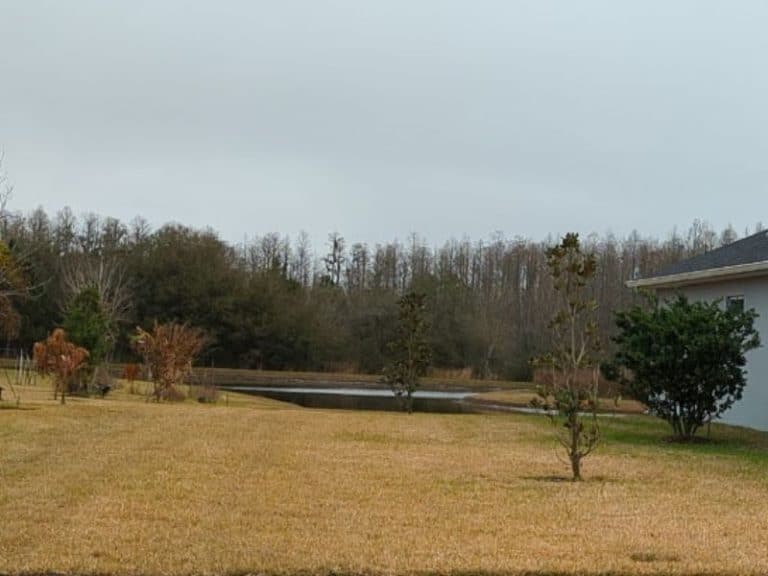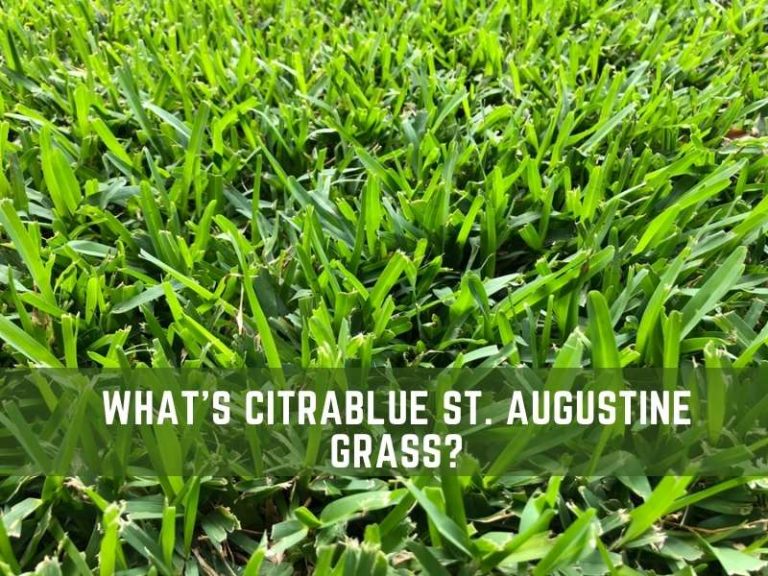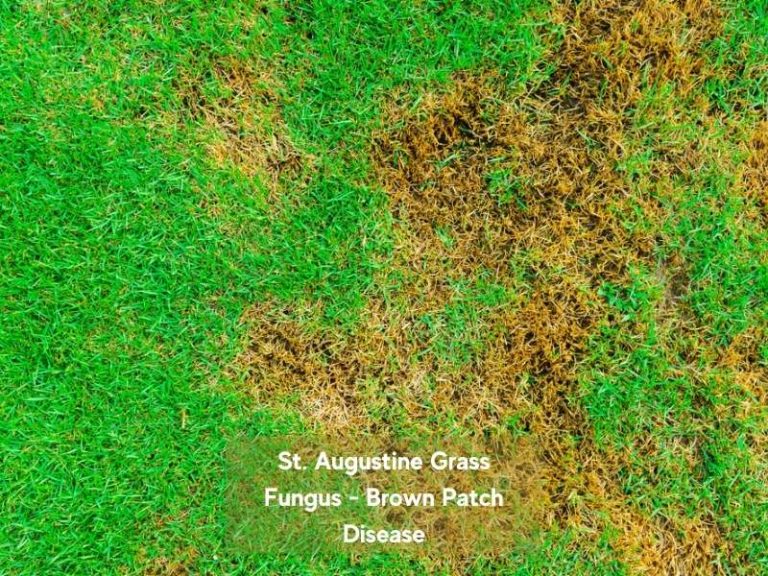Brown Patch in St. Augustine Grass-How to Treat + Best Fungicides
Dead grass and unappealing brown patches are a valid cause to worry about the deteriorating state of your lawn. They might result from bad climate, negligence, or accidental factors. There are ways to cure and prevent fungal diseases in your St. Augustine turf.
Brown patches in turf indicate a fungal infection. While there are numerous causal elements such as grub infestation, irregular patches in your St. Augustine grass point to fungal diseases. Depending on the infection’s severity, the patches size in brown patches may vary from tiny to several feet in diameter.
What is brown patch disease?
Brown patch disease or large patch disease is a foliar condition caused by the Rhizoctonia Solani fungus. The fungus thrives primarily during mid to late summer when it is hot (70° to 90° F) and humid. It’s easier to notice augmented grass damage in the form of brown patches because of heat stress during this season.
Rhizoctonia fungus stems from a central point. Brown patch disease spreads fast when it attacks your St. Augustine grass. It appears as brown circular areas, with dead grass circled in by a narrow dark ring most visible when there’s dew on the grass. However, patches do not have to be circular. Patches combine to form irregular-shaped dead spots that die down to form sunken areas in your turf.
Signs of brown patch in St. Augustine grass
Leaf-blades bear the most prominent Indications of brown patch disease because it’s a foliar disease. Signs vary depending on the magnitude of fungal infection. Typically, patches of six to twelve inches of discoloration show as the infection starts. These patches start as yellow bits and develop into larger brown patches. Further spread causes the merging of patches resulting in profound areas of turf turning brown.
It is vital to conclusively diagnose brown patch disease in your St. Augustine grass to eliminate other potential causes of brown patches on your lawn. Look out for these signs of fungus on St. Augustine grass.
Random yellowing of grass blades
Lush grass is a good indicator of healthy turf. Any slight change in grass color indicates disease or infestation by pests.
Since brown patch disease primarily affects the grass blades, yellowing will be the first indicator of a fungal attack. The Rhizoctonia fungus causes St. Augustine’s grass blades to turn yellow.
If you do not catch the fungus at this stage, the grass blades will turn brown, and magnified grass degradation will start.
If you have pets, pet urine might also cause such yellowing. Consult a professional to confirm whether your lawn has fungal infections.
Rotting stolons
The stolon is a slender stem that grows horizontally along the ground. This stem gives rise to roots and fresh blades of grass from nodes. When Rhizoctonia Solani fungus attacks the stolons, they rot and die slowly. Affected stolons turn yellow, then brown, and become a rotten mash.
With rotten stolons, your St. Augustine lawn will not sprout fresh grass blades. It will result in bare spots on your lawn. It isn’t easy to notice stolons in healthy turf. However, fungal diseases expose the rotting stems by leaving patches without grass.
Irregular brown spots and patches
The size of these brown patches will vary depending on your soil conditions. Fungus thrives in:
- Compacted soil
- Overwatered soils
- Soil with low nitrogen levels
- Acidic soils
The fungus has already spread When your lawn exhibits brown patches, a few inches to several feet in diameter. When under fungal attack, St. Augustine grass blades form dark-brown color around the patch edges near the soil’s surface and irregular tan spots that resemble a burned cigarette.
Additionally, brown spots and patches might show grub infestation or pet urine on your lawn.
If you suspect fungal diseases in your lawn, send a grass or soil sample to lawn care experts or invite them to analyze and give conclusive results.
Dark brown or gray fungal threads in your grass
Fungus in St. Augustine grass also presents itself as web-like threads on stolons or crowns of grass. Gray or dark brown threads are an obvious sign of Rhizoctonia fungus and a spectrum of other fungal diseases.
These threads become highly visible as small patches on your lawn after a rainy session. Ultimately, these fungal threads cause the grass blades to rot in the areas they cover, resulting in dead grass.
Some of these signs may be common to other fungi, diseases, or due to pest infestation and pet urine.
Contact a professional lawn care company to ascertain what is affecting your St. Augustine turfgrass.
How to treat brown patch in St. Augustine grass
Brown patch disease is caused by practices that are controllable and avoidable. Proper lawn maintenance eliminates chances of Rhizoctonia Solani attack. Practices such as timely and adequate watering and applying appropriate fertilizers go a long way in treating and maintaining your St. Augustine grass lawn.
Implement these steps to treat brown patches in St. Augustine grass.
Reduce soil compaction
Compact soil is more susceptible to fungal infections. Compaction means the soil lacks aeration. Typically, your lawn shows the following signs to indicate compaction.
- Water running off the soil surface instead of being absorbed
- Stagnation or pooling of water in your lawn
- Areas in the lawn where grass and even weeds refuse to grow
Decompaction improves soil aeration. Use a plug aerator on high foot traffic areas, outdoor activity areas, or areas with heavy lawn furniture to loosen soil particles on your lawn. Another method of de-compaction includes introducing earthworms to the soil and promoting water penetration into the soil.
Reducing soil compaction eliminates flooding and prevents the growth of fungi.
Timely and adequate watering
Watering grass early in the morning allows enough time for the grass blades to dry. Since damp grass promotes the growth of fungi, adequate and timely watering makes the environment unfavorable for the growth and spread of Rhizoctonia Solani.
Moreover, water grass only when it shows signs of drought, which is five to ten days for St. Augustine turf. This will prevent unnecessary watering. The recommended depth into the ground where the water reaches is four to six inches. However, the amount of water needed varies depending on your lawn’s drainage. Soil that seeps water slowly needs minimal water addition to prevent logging.
Correctly apply nitrogen fertilizers
Adding nitrogen fertilizers too early or too late in the season leads to fungi growth. Rhizoctonia Solani enjoys soft and fresh lush grass. Fertilize late in the summer since nitrogen fertilizers support the healthy growth of grass.
The timely application of nitrogen fertilizer promotes grass growth, making your turf strong and resistant to fungi.
Before application, conduct a soil test to determine the right amount of nutrients needed. Apply soluble nitrogen every eight weeks and slow-release nitrogen every ten weeks.
Mowing
Control grass clippings by mowing your yard regularly. Mow your St. Augustine grass to a height of 2.5 to 3 inches every ten days. Timely grooming and maintenance will prevent the buildup of grass clippings. Clippings piling up creates excessive thatch, leading to excessive moisture buildup, the optimum environment for the growth of fungi.
Best fungicide for brown patch
The most vital aspect of fungicide application is ensuring the product eliminates brown patch and remain safe for your St. Augustine lawn. The best fungicides for brown patch disease contain azoxystrobin, pyraclostrobin, or fluoxastrobin as active ingredients. Apply fungicides in 14 to 28-day intervals, depending on the composition and efficacy of the product.
Alternate fungicides to prevent resistance. Also, use liquid spray fungicides that are easier to apply than granular fungicides which require watering. The following fungicides eliminate brown patches without harming your turf.
1. Green Light Spectrum Mancozeb Fungicide
Green Light Spectrum Mancozeb Fungicide is a wettable powder. Mix it with water in the recommended ratio on the label. This fungicide contains Mancozeb as an active ingredient, which has the following features.
- It is a group M multi-site fungicide with a low risk of resistance
- It disrupts the biochemical processes in fungi systems.
- It binds to the soil to disrupt fungi growth from the root.
Changes occur within 14 days of application, which is as long as the fungicide lasts before you have to reapply. Repeat applications are necessary in severe cases.
2. Scotts DiseaseEx Lawn Fungicide
This is a fungicide that works on brown patch disease as quickly as 24 hours after application. It contains 0.31% azoxystrobin as an active ingredient that inhibits the germination of spores and is safe for St. Augustine grass. It comes ready to be broadcasted on your lawn, followed by a light watering up to half an inch of water.
If your turf has a lot of fungi, you might need to continue applying the Scotts DiseaseEx Lawn Fungicide until results show. It lasts up to four weeks after application and works by curing your turf and preventing fungi growth.
3. Bayer Advanced Lawn Fungus Control
This fungicide comes in granular form, meaning you have to water it after application. Bayer Advanced Lawn Fungus Control has Triadimefon as an active ingredient. It is effective in eliminating brown patch disease. Due to its systemic properties, it is absorbed into the turf, suppressing the fungus from within the grass blade.
It will take at least seven days to see a positive transformation on your lawn. Bayer Advanced Lawn Fungus Control protects your lawn for up to 25 days after application. Severe cases must be treated as such by re-treating and seeking help from professionals if nothing improves.
Fungicides are chemical products. Observe safety measures as follows during application.
- Wear protective equipment such as eye gear.
- Wear a face mask to avoid inhalation of fumes and chemicals
- Wear gloves. Some strong chemicals might corrode your hands.
- Observe post-application measures accordingly. Such measures include not entering the sprayed area for up to 48 hours or as advised on the product label.
Can St. Augustine recover from the brown patch?
This fungal infection cannot kill your St. Augustine grass unless your turf was unhealthy before brown patch disease. It is a temporary problem solved by readjusting maintenance practices, such as watering, fertilizing, and mowing. Severe cases will require fungicide application to eliminate and prevent further fungal attacks. Employ treatment measures accordingly, and your turf will be healthy and lush.
In some severe cases, you have to be more patient until the active growing season to see an improvement in appearance. Although fungicide application cures and prevents the spread of fungi to other areas, the rotted spots will need to re-grow. Re-growth is dependent on watering and fertilizing to provide appropriate nutrients for your turf.
References
- Prairie View A&M University, AgriLife Extension: Brown Patch Disease of Lawns-Introduction
- University of Missouri, Integrated Pest Management: If Your Lawn is Cool, Stop Fertilizing it NOW!
- Jason Gray, Extension Assistant, The Texas A&M University System, Turfgrass Management: Maintaining St. Augustine Grass Lawns
- Joey Williamson, Ph.D., HGIC Horticulture Extension Agent, Clemson University: Brown Patch & Large Patch Diseases of Lawns
- Doug Caldwell, Commercial Horticulture Educator, University of Florida, IFAS Extension: Brown Patch Disease of St. Augustine Grass




